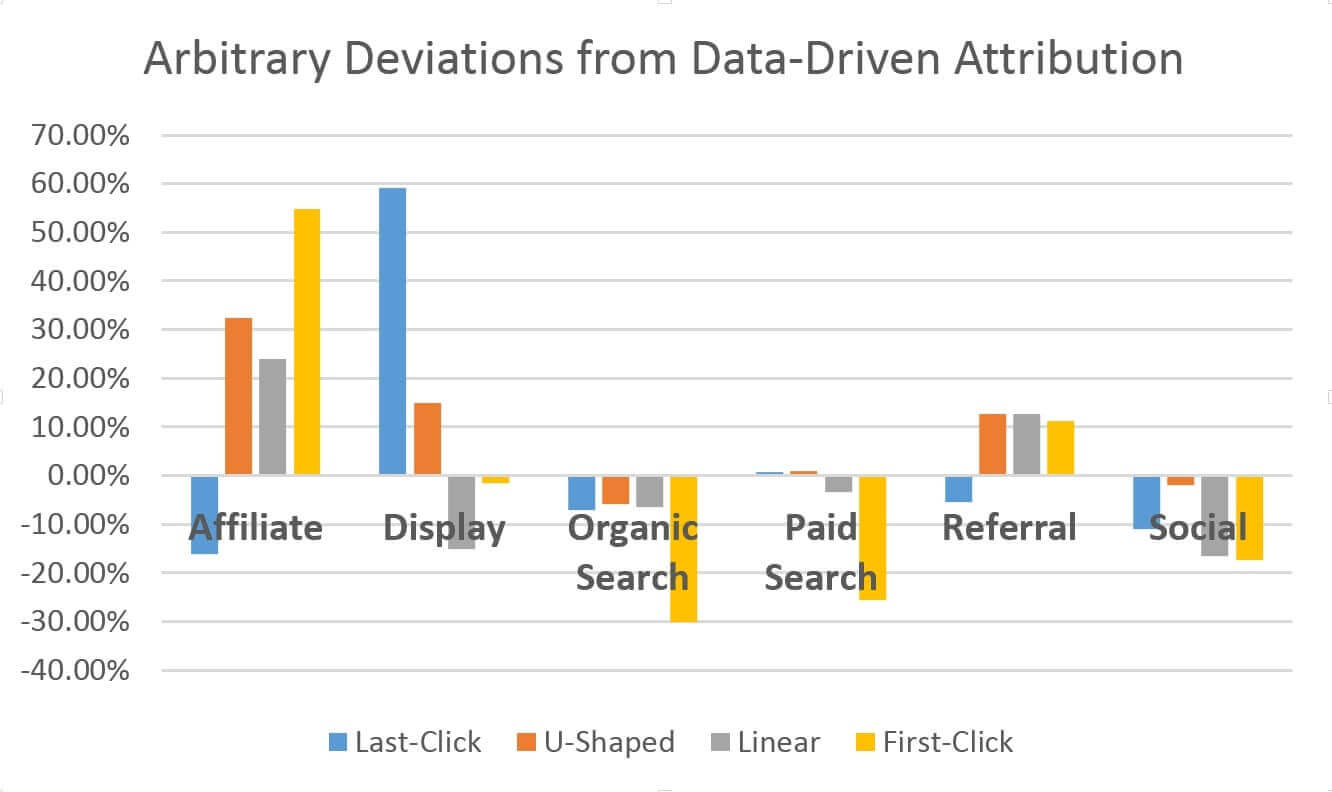Why Last-Click is the Last Thing to be Applied in Marketing
When comparing the well known and mostly used by default last-click attribution against the credible data-driven approach, it becomes clear how dangerous sticking to last-click attribution can be. Looking at only the last marketing interaction before a conversion is similar to only paying a salary to the players that scored a touchdown in the NFL. Experienced marketing managers know that attributing with last-click logic leads to inferior budget allocation and inefficient marketing management.
The tricky thing for marketers is figuring out each touchpoint’s contribution to the final conversion event. Getting this right can indicate which marketing campaigns are the most important in the marketing mix and which hardly contribute any results. Static attribution such as last-click work based on assumptions and rules. They usually are applied as pre-set in tools like Google Analytics / GA4 leading to a wide-spread usage simply by default. However, only because almost everybody applies a last-click attribution, it doesn’t make it correct, effective or at all suitable for your specific business.
The actual question that comes to mind is not whether but rather how wrong last-click attribution really is. For example, how high is the proportion of incorrectly attributed conversions using the static last-click model?
As a provider of data-driven and machine-learning based attribution modeling, we used our aggregated customer data to calculate an answer. To do this, we looked at all Adtriba clients to see how many conversions would be attributed to a channel based on last-click. We then compared this last-click attribution to the number of conversions attributed to the same channel according to our data-driven attribution model.
Additionally, we looked at how much the numbers differ compared to the other common static attribution models: first-click, linear and u-shaped. The majority of marketers we speak to uses last-click attribution. But some also apply alternatives, because they seem less wrong than last-click. Here is a descriptive overview of our findings:


59% median difference for Display/last-click means, that for half of Adtriba'a clients Display was undervalued by at least 59% (e.g. Adtriba Attribution model: 1000 conversions, last-click model: 409 conversions) or more when assuming last-click.
With this we observe a trend for overvaluation of Organic Search and Social through all static attribution models. Other than that, no particular patterns could be identified when looking at these stats. This indicates just how arbitrary static attribution models are.
Where rule-based and static attribution models clearly fail, is that they only take into account successful marketing touchpoints and completely neglect the unsuccessful ones. This means they do not account for the actual efficiency of a particular marketing campaign. This might sound abstract so let’s look at an example: In soccer teams the manager will always evaluate players by their efficiency, i.e. analyze their successful and unsuccessful moves. Mid-fielders get evaluated by what their passing-rate is and defensive players by how many direct combats they’ve won. This analysis logic can and should be transferred to customer journeys in marketing. This can be done with data-driven attribution that takes into account both - converting and non-converting customer journeys. By doing so, analyzing marketing campaign efficiency becomes unbiased and from a data analytics perspective, finally accurate. Static models like last-click miss this wholeness of data points and therefore plainly report wrong results.
On average paid search brand campaigns are overvalued by 30%
Coming back to our analysis, we had quite a controversial and intense discussion regarding attribution when it comes to paid search brand campaigns. Many larger brands conducted tests and found that their branded search was significantly overvalued. Branded searches tend to happen in the lower funnel of the customer’s journey, meaning they are typically closer to the conversion. Obviously, this leads to branded searches benefiting from a last-click attribution, potentially leading to overvaluation. In our clients data, we looked for indications to prove this hypothesis and found that on average paid search brand campaigns are overvalued by 30% when using last-click compared to the Adtriba data-driven model.
It’s crucial to understand that these are highly aggregated statistics. They aim to illustrate the consequences of sticking to last-click or any of the other static models for your business. These numbers are by no means actionable insights to derive operative actions. Just because affiliate campaigns have been overvalued on average, doesn’t mean that spending in all affiliates should be reduced. Neither do our insights justify an increased spending in all display ad campaigns. In order to optimize budget allocations for campaigns and advertising, specific data-driven attribution models need to be applied specifically to your particular business metrics and your individual customer journeys.
In the end, all static attribution models are plainly wrong. There is no statistical reason why every customer journey should behave along the same distribution pattern or why your customers’ journey should follow the same distribution as your competitors’. More sophisticated statistical methods, such as data-driven attribution based on machine learning can create an individual attribution model for your company’s specific customer journeys and marketing mix.
The purpose of data-driven Attribution Modeling is not to showcase the absolute truth. Rather, working with data-driven attribution modeling is an ongoing process, algorithms are recalculated regularly to account for changes in user-behavior, market trends, price changes etc. This ongoing, iterative and flexible way of attributing results helps to improve marketing decisions and marketing ROI. Moving away from static attribution models and starting with a data-driven approach means jumping ahead into the right direction to improve your business.